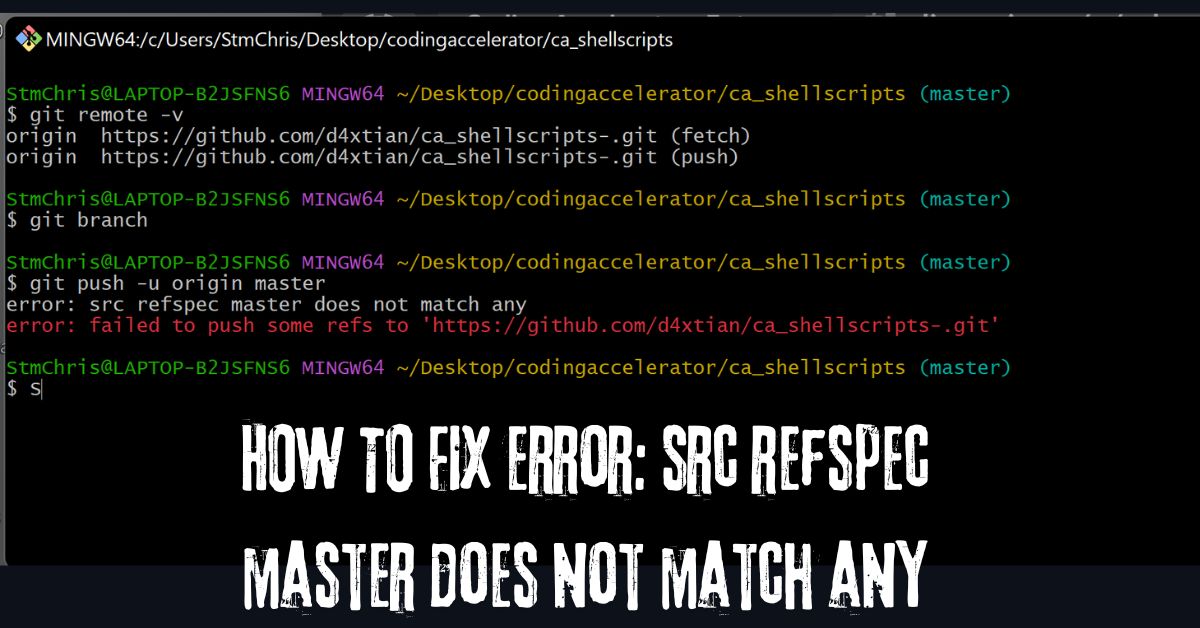When working with Git, it is not uncommon to encounter errors that can hinder the smooth operation of your workflow. One such error is the “src refspec master does not match any” message, which can be frustrating to deal with, especially if you are new to Git. In this article, we will delve into the causes and solutions of this error, as well as provide a concise FAQ section to help you quickly resolve the issue.
TRENDING
Jablw.rv: A Comprehensive Overview
Causes of the Error
The “src refspec master does not match any” error typically occurs when you are trying to push or pull changes from a remote repository, but the local branch does not match the remote branch. This can happen for several reasons:
- Branch Names Do Not Match: The most common cause of this error is when the branch names on your local machine do not match the branch names on the remote repository. For example, if you have a local branch named “feature/new-login-system” but the remote repository has a branch named “feature/new-login-system-1“, Git will not be able to find a matching branch and will throw this error.
- Branch Does Not Exist: Another common cause is when the branch you are trying to push or pull does not exist on the remote repository. For instance, if you have a local branch named “feature/new-login-system” but the remote repository does not have a branch with that name, Git will not be able to find a matching branch and will throw this error.
- Incorrect Branch Name: Sometimes, the error can occur due to a typo in the branch name. For example, if you have a local branch named “feature/new-login-system” but you accidentally type “feature/new-login-syste” when trying to push or pull, Git will not be able to find a matching branch and will throw this error.
Solutions to the Error
To resolve the “src refspec master does not match any” error, you can try the following solutions:
- Check Branch Names: Verify that the branch names on your local machine match the branch names on the remote repository. Make sure to check for any typos or incorrect capitalization.
- Create the Branch on the Remote Repository: If the branch does not exist on the remote repository, you can create it using the following command:bash
git push origin <branch-name>Replace<branch-name>with the name of the branch you want to create. - Push or Pull Specific Branch: If you are trying to push or pull a specific branch, make sure to specify the branch name in the command. For example:bash
git push origin feature/new-login-systemThis will push the “feature/new-login-system” branch to the remote repository. - Use the
-uFlag: When pushing or pulling, you can use the-uflag to update the upstream tracking information. This can help resolve issues with branch names not matching:bashgit push -u origin feature/new-login-system
Conclusion
The “src refspec master does not match any” error can be frustrating to deal with, but it is often a simple issue to resolve. By understanding the causes of the error and following the solutions outlined in this article, you should be able to quickly resolve the issue and continue working with your Git repository. Remember to always check branch names for typos or incorrect capitalization, create branches on the remote repository if they do not exist, specify branch names when pushing or pulling, and use the -u flag to update upstream tracking information.
ALSO READ: Luv.Trise
FAQ: Resolving the “src refspec master does not match any” Error
Q: What does the “src refspec master does not match any” error mean?
A: The “src refspec master does not match any” error means that Git cannot find a matching branch on the remote repository. This can happen due to differences in branch names, branch not existing on the remote repository, or incorrect branch names.
Q: How do I resolve the “src refspec master does not match any” error?
A: To resolve the error, check branch names for typos or incorrect capitalization, create the branch on the remote repository if it does not exist, specify the branch name when pushing or pulling, and use the -u flag to update upstream tracking information.
Q: What is the -u flag used for in Git?
A: The -u flag in Git is used to update the upstream tracking information. This can help resolve issues with branch names not matching and ensure that your local branch is tracking the correct remote branch.
Q: Can I push or pull multiple branches at once?
A: Yes, you can push or pull multiple branches at once using the --all flag. For example:
bashgit push origin --all
This will push all local branches to the remote repository.











